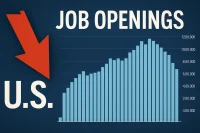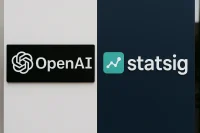Private Sector Job Market Hits Roadblock as ADP Reports First Decline Since 2023
The US labor market has reached a critical turning point, with the latest ADP National Employment Report revealing that private sector employment unexpectedly shed 33,000 jobs in June. This marks the first contraction in private sector employment since March 2023 and falls significantly below economists’ expectations of a 100,000 job increase. The surprising decline signals potential trouble ahead for the US economy as employers appear increasingly hesitant to hire amid economic uncertainty.
Behind the Numbers: Sectors Showing Weakness
The June ADP report exposes concerning sectoral disparities that paint a complex picture of the current job market. Professional and business services were hit hardest, losing 56,000 positions, while education and health services—typically resilient sectors—shed 52,000 jobs. Financial activities also contracted, dropping 14,000 positions.
These losses were partially offset by gains in:
- Leisure and hospitality: +32,000
- Manufacturing: +15,000
- Trade/transportation/utilities: +14,000
- Construction: +9,000
- Natural resources/mining: +8,000
“Though layoffs continue to be rare, a hesitancy to hire and a reluctance to replace departing workers led to job losses last month,” explained Dr. Nela Richardson, chief economist at ADP. “Still, the slowdown in hiring has yet to disrupt pay growth.”
Small Businesses Bear the Brunt of Employment Contraction
The employment decline wasn’t distributed evenly across businesses of different sizes. Small businesses suffered the most significant impact:
- Small businesses (fewer than 50 employees): -47,000 jobs
- 1-19 employees: -29,000
- 20-49 employees: -18,000
- Medium-sized businesses (50-499 employees): -15,000 jobs
- 50-249 employees: +12,000
- 250-499 employees: -27,000
- Large businesses (500+ employees): +30,000 jobs
This disparity highlights the vulnerability of smaller enterprises in the current economic climate, while larger corporations appear better positioned to weather uncertainty.
Regional Disparities Reveal Uneven Economic Recovery
The geographic distribution of job losses reveals significant regional differences:
- Midwest: -24,000 jobs
- West: -20,000 jobs
- Northeast: -3,000 jobs
- South: +13,000 jobs
Within these regions, the South Atlantic lost 21,000 jobs, while the Mountain region shed 20,000 positions. The West North Central region experienced the steepest decline with 28,000 jobs lost. Meanwhile, the East South Central (+20,000) and West South Central (+14,000) regions showed resilience with positive job growth.
Wage Growth Remains Steady Despite Employment Contraction
Despite the concerning employment figures, wage growth has remained relatively stable:
- Job-stayers saw annual pay growth of 4.4% (down slightly from 4.5% in May)
- Job-changers experienced wage increases of 6.8% (compared to 7.0% in May)
This persistent wage growth amid job losses presents a complex challenge for the Federal Reserve as it weighs potential interest rate cuts against inflation concerns.
What This Means for the Economy and Federal Reserve Policy
The unexpected job losses reported by ADP could increase pressure on the Federal Reserve to accelerate interest rate cuts. However, the relatively stable wage growth complicates the picture, as it suggests continued inflationary pressure in the labor market.
“This will increase pressure on the Federal Reserve to cut rates, but it won’t change anything about the concern they have over potential inflation,” noted one economic analyst. “It really just kind of deepens the stagflationary concern that we’ve heard from fed officials.”
Is This the Beginning of a Broader Downturn?
The June ADP report raises important questions about whether this employment contraction represents a temporary blip or the beginning of a more significant economic slowdown. Several factors could be contributing to employers’ hiring hesitancy:
- Policy uncertainty: Ongoing debates about tariffs and trade policies may be causing businesses to delay hiring decisions
- Consumer spending slowdown: Recent data suggests consumers may be pulling back on spending
- Rising business costs: Persistent inflation in certain sectors may be squeezing profit margins
- Labor market rebalancing: After years of worker shortages, the market may be normalizing
“I think the best days of the labor market are behind us, but I do think that there could be a resurgence down the road for a variety of reasons, after we hit maybe a small speed bump,” suggested market analyst Rick Santelli. “And I think that’s the real issue here. Are we going to get a genuine slowdown or a small hiccup? I’m in the latter camp.”
What Job Seekers Should Know
For those currently in the job market, the ADP report suggests a potentially more challenging environment ahead for job seekers:
- Competition for available positions may increase
- Smaller businesses may be more cautious about hiring
- Certain sectors (professional services, education, healthcare) may offer fewer opportunities
- Regional job markets show significant variation in strength
- Wage growth remains strong for those who secure new positions
Stay Ahead in a Competitive Job Market
With hiring trends shifting and opportunities tightening in some sectors, it’s more important than ever to act fast. Explore thousands of active job listings across industries and locations—before your competition does.
Find Jobs NowImplications for Businesses and Investors
The unexpected job losses have several implications for businesses and investors:
- Small business owners may need to prepare for a more challenging economic environment
- Investors should watch for signs of whether this contraction is temporary or the beginning of a broader trend
- Large corporations appear better positioned to weather economic uncertainty
- Sector-specific strategies may be necessary as different industries show varying levels of resilience
Looking Ahead: What to Watch For
As the economy navigates this potential inflection point, several key indicators will be worth monitoring:
- Government jobs report: The official Bureau of Labor Statistics employment report will provide a more comprehensive picture
- Consumer spending data: Any further pullback could signal deeper economic troubles
- Federal Reserve statements: How policymakers interpret these mixed signals will be crucial
- Additional ADP reports: Whether July shows continued contraction or a rebound will be telling
- Small business sentiment: Further deterioration could indicate a broader slowdown
The Labor Market’s Delicate Balance
The labor market has been a pillar of strength throughout recent economic challenges, but the June ADP report suggests that pillar may be weakening. The coming months will be crucial in determining whether this represents a temporary setback or the beginning of a more significant economic shift.
“Eventually standing in place creates a drain on job growth,” one analyst noted. “The reason is because people leave the job market if you don’t hire more people. So what we’ve heard is not so much firing. It’s a lack of hiring over time that creates a saps the strength of the labor market.”
FAQ: Understanding the Labor Market Slowdown
What does the negative ADP jobs report mean for the economy?
The unexpected loss of 33,000 private sector jobs suggests potential economic weakness and may indicate businesses are becoming more cautious about hiring amid uncertainty. While one month doesn’t make a trend, this report raises concerns about whether the labor market’s resilience is fading.
Which industries are still hiring despite the overall job losses?
Despite the overall decline, several sectors continued to add jobs in June, including leisure and hospitality (+32,000), manufacturing (+15,000), trade/transportation/utilities (+14,000), and construction (+9,000). These sectors appear more resilient in the current economic environment.
How does this labor market slowdown affect job seekers?
Job seekers may face increased competition for available positions, particularly in sectors experiencing contraction like professional services and education/healthcare. However, opportunities remain in growing sectors, and wage growth for new hires remains strong at 6.8% annually.
Will this jobs report influence Federal Reserve policy on interest rates?
The unexpected job losses increase pressure on the Federal Reserve to consider accelerating interest rate cuts. However, persistent wage growth complicates the picture as it suggests continued inflationary pressures, creating a challenging balancing act for policymakers.
Are small businesses or large corporations better positioned in this economic environment?
The ADP report shows large businesses added 30,000 jobs while small businesses lost 47,000 positions, suggesting larger corporations are better positioned to navigate current economic uncertainties. Small businesses appear more vulnerable to the changing economic landscape.




